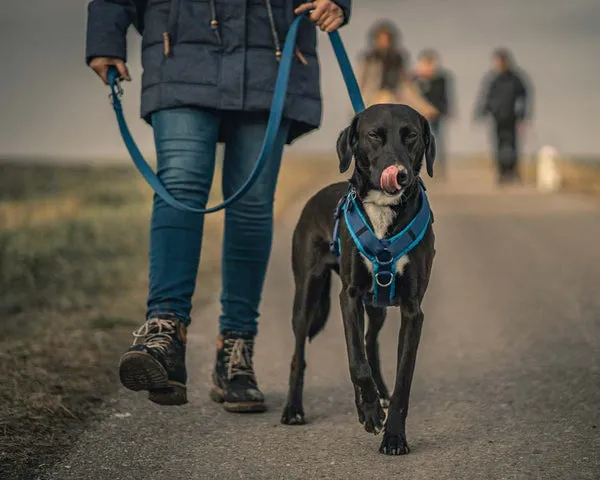Many dog owners have experienced the disheartening struggle of a dog that constantly pulls on the leash, making walks feel less like a pleasant stroll and more like a wrestling match. This common issue can lead to discomfort for both you and your canine companion, often resulting in your dog pulling on the leash and choking, a scenario that is not only frustrating but also potentially dangerous for their health. While the desire for a relaxing walk with your beloved pet is strong, the reality of a dog straining against their collar can quickly turn an enjoyable outing into a stressful chore. This article will delve into effective, humane training methods to teach your dog to walk calmly by your side, transforming your walks into positive experiences for both of you.
The Dangers of Choke Collars and Harmful Leash Devices
When faced with a dog that pulls excessively, it’s natural to seek solutions. Many products on the market claim to instantly correct leash pulling, but it’s crucial to understand the mechanisms behind them and their potential consequences. One such device that should be avoided is the choke collar, a tool based on negative reinforcement and punishment.
Why Choke Collars Are Detrimental
Choke collars operate by tightening around a dog’s neck when they pull on the leash. While this may seem like an immediate deterrent, it carries significant risks. If your dog is already anxious or nervous during walks, the sudden pressure and sensation of choking can exacerbate their fear, potentially leading to panic, harder pulling, or attempts to escape the aversive device. This creates a highly negative association with walks and can severely damage the bond between you and your pet.
The Problem with Negative Reinforcement
One of the biggest issues with relying on negative reinforcement strategies, especially those involving discomfort or pain, is that they do not effectively teach your dog what to do. When a dog sees a squirrel and pulls, the choke collar tightens. The dog experiences an unpleasant sensation but doesn’t learn that the desired behavior is to walk calmly beside you with a loose leash. They only learn to associate pulling with pain, which can be confusing and counterproductive.
Furthermore, negative reinforcement inherently involves a positive punisher. The act of pulling is punished by the choke. While the collar may loosen if they stop pulling, the initial experience is one of punishment, which has multiple harmful side effects. This method primarily focuses on suppressing an unwanted behavior rather than reinforcing a desired one.
Harmful Side Effects: Apathy, Aggression, and Fear
Using punishment and negative reinforcement, such as choke collars, can lead to several harmful psychological and behavioral side effects in dogs. One such effect is apathy, where your dog may lose all interest in going for walks. They might simply give up because every attempt to walk is met with discomfort, leading to a loss of enjoyment and engagement. It becomes confusing for them to understand what you want, especially if they are pulling in multiple directions due to excitement or distraction.
Aggression is another serious side effect. In an attempt to stop the choking sensation, a dog might try to bite at the leash or even at you. This is a natural reaction to an unpleasant stimulus. Beyond aggression, dogs can develop generalized fear. This fear might extend to the leash itself, the act of walking, or even to you, their owner, if you are consistently associated with the painful experience. In severe cases, they might develop fear of all humans. Such fear often manifests as escape/avoidance behaviors; your dog might run and hide when they see the leash, resist having the collar put on, or even fight against it. Subjecting your dog to such discomfort is unnecessary when more humane and effective alternatives exist.
Safer Alternatives: The Gentle Lead Harness
If you are seeking a physical aid to help manage leash pulling, a much safer and more humane option than a choke collar is a gentle lead harness (often referred to as a front-clip harness or head halter). These harnesses typically tighten around the chest or muzzle, providing a signal to your pet rather than a strong punisher. The pressure around the chest or muzzle is less aversive and helps to redirect your dog’s attention and movement without causing pain or fear.
The effectiveness of a gentle lead harness is amplified when combined with active training using positive reinforcement. It serves as a helpful management tool while you teach your dog the desired behavior of walking politely, rather than being a standalone “training” device. This approach focuses on guiding your pet and rewarding them for making the right choices, leading to a more cooperative and enjoyable walking experience.
 A black and white Border Collie sits attentively on pavement, looking up with a focused expression.
A black and white Border Collie sits attentively on pavement, looking up with a focused expression.
Understanding Your Dog’s Motivation: What Pulling Achieves
Often, when our dogs exhibit unwanted behaviors, our immediate reaction is to simply make them stop. We say, “I want my dog to stop barking,” or “I want my dog to stop pulling on the leash.” While these desires are valid, a more effective approach is to consider what we would like them to do instead. Every behavior serves a purpose; there’s always an underlying reason why your dog acts the way it does. Denying them an outcome they seek without offering an alternative is far less effective than teaching them a different behavior that achieves the same desired outcome.
Teach Them What to Do Instead of Just “Stop”
Consider a dog that jumps all over you when you come home. They are craving attention, affection, and excitement. Simply pushing them away and saying “no” doesn’t teach them how to get that attention in an acceptable way. If you instead teach them to sit when you arrive, and reward them for it, they will learn that sitting is the new way to get your attention and affection. You’ll likely see a significant reduction in jumping because they are getting the same desired outcome through a different, approved behavior. This principle applies directly to leash pulling.
The Purpose Behind Leash Pulling
So, why do dogs pull on the leash during walks? In most cases, the answer is simple: they want to get to where they’re going, which is the walk itself. Just like an excited dog jumping for attention, a dog pulling on the leash is often driven by the excitement of exploring, smelling new things, or reaching a destination. When they pull, and we continue walking, they learn that pulling works – it gets them what they want. This reinforces the pulling behavior, making it more likely to happen again.
Therefore, the goal is to teach them that walking politely by your side (heeling) is the behavior that leads to the same desired outcome: getting to go on a walk. This shift in understanding is fundamental to changing the behavior. It sounds straightforward, but implementing it effectively requires consistent positive reinforcement. By making the walk contingent on good behavior, you can eliminate the frustrating pulling on the leash.
 A black Labrador mix dog walks calmly on a wide path, wearing a blue harness and leash, with a person beside it.
A black Labrador mix dog walks calmly on a wide path, wearing a blue harness and leash, with a person beside it.
Positive Reinforcement: Reinforcing Calm Leash Walking
Now, you might wonder, if the ultimate reward for not pulling is the walk itself, why do we need to introduce other reinforcers like treats? This is an excellent question and ties back to teaching them what to do instead. Positive reinforcement is the strongest form of communication we have with our dogs. It clearly signals which behaviors we want them to repeat.
Building Desired Behavior with Treats and Rewards
To initially teach your dog to walk gently and calmly by your side, using high-value treats is incredibly effective. If you consistently reward your dog with a small, delicious treat every time they walk politely with a loose leash, they will quickly understand that walking in that specific manner leads to a positive outcome. This helps them associate the desired behavior with a reward, making them more likely to offer it voluntarily. Treats are not a “crutch” or a sign that your dog is “winning”; rather, they are a powerful communication tool. If a handful of treats means you can enjoy a peaceful walk without your dog pulling and choking on the leash, and without resorting to aversive methods, it’s an absolute win for both of you. It fosters a positive training environment based on mutual understanding and communication.
Transitioning to the Walk Itself as a Reinforcer
Once your dog consistently understands and performs the desired loose-leash walking behavior with the help of treats, you can gradually begin to transition the primary reinforcer. The walk itself, with all its sights, smells, and sounds, becomes the ultimate reward. Your dog will start to internalize the idea that “this is how we walk” – calmly, by your side, with a loose leash – because this behavior consistently leads to the enjoyable experience of a walk. This process creates a lasting positive association, ensuring both you and your furry friend can enjoy peaceful and pleasant walks together.
 A Bernese Mountain Dog holds a leather leash in its mouth, looking back playfully.
A Bernese Mountain Dog holds a leather leash in its mouth, looking back playfully.
Transforming a dog that pulls on the leash and chokes into a calm walking companion is entirely achievable through patience, consistency, and the application of humane, positive reinforcement techniques. By understanding why your dog pulls and teaching them alternative, desired behaviors, you can move away from harmful methods like choke collars and embrace strategies that strengthen your bond and improve their well-being. Focus on rewarding good behavior, utilizing tools like gentle lead harnesses if needed, and gradually transitioning to the walk itself as the ultimate reinforcer. The result will be not only a well-behaved dog but also a happier, more harmonious walking experience for both of you, making every outing a joy rather than a struggle.
